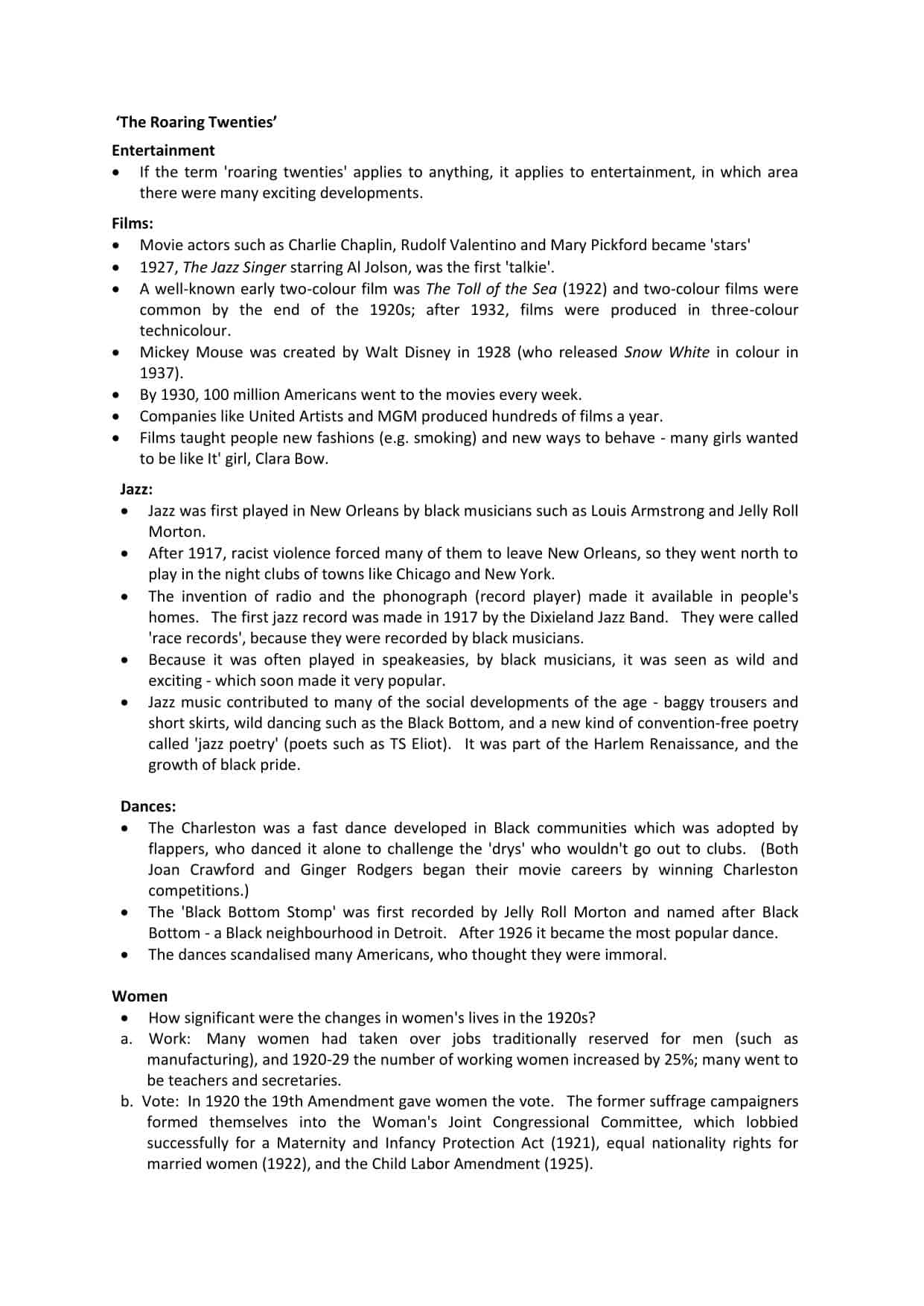Premium

Download USA Roaring Twenties iGCSE Revision Notes
Click the button below to download this worksheet for use in the classroom or at home.
Download →
The Roaring Twenties Facts & Information:
- Entertainment
- If the term ‘roaring twenties’ applies to anything, it applies to entertainment, in which area there were many exciting developments.
Films: - Movie actors such as Charlie Chaplin, Rudolf Valentino and Mary Pickford became ‘stars’
- 1927, The Jazz Singer starring Al Jolson, was the first ‘talkie’.
- A well-known early two-colour film was The Toll of the Sea (1922) and two-colour films were
common by the end of the 1920s; after 1932, films were produced in three-colour
technicolour. - Mickey Mouse was created by Walt Disney in 1928 (who released Snow White in colour in
1937). - By 1930, 100 million Americans went to the movies every week.
- Companies like United Artists and MGM produced hundreds of films a year.
- Films taught people new fashions (e.g. smoking) and new ways to behave – many girls wanted
to be like It’ girl, Clara Bow.Jazz: - Jazz was first played in New Orleans by black musicians such as Louis Armstrong and Jelly Roll Morton.
- After 1917, racist violence forced many of them to leave New Orleans, so they went north to play in the night clubs of towns like Chicago and New York.
- The invention of radio and the phonograph (record player) made it available in people’s
homes. The first jazz record was made in 1917 by the Dixieland Jazz Band. They were called ‘race records’, because they were recorded by black musicians. - Because it was often played in speakeasies, by black musicians, it was seen as wild and exciting – which soon made it very popular.
- Jazz music contributed to many of the social developments of the age – baggy trousers and short skirts, wild dancing such as the Black Bottom, and a new kind of convention-free poetry called ‘jazz poetry’ (poets such as TS Eliot). It was part of the Harlem Renaissance, and the growth of black pride.
Dances: - The Charleston was a fast dance developed in Black communities which was adopted by flappers, who danced it alone to challenge the ‘drys’ who wouldn’t go out to clubs. (Both Joan Crawford and Ginger Rodgers began their movie careers by winning Charleston competitions.)
- The ‘Black Bottom Stomp’ was first recorded by Jelly Roll Morton and named after Black Bottom – a Black neighbourhood in Detroit. After 1926 it became the most popular dance.
- The dances scandalised many Americans, who thought they were immoral.Women
: How significant were the changes in women’s lives in the 1920s?
a. Work: Many women had taken over jobs traditionally reserved for men (such as
manufacturing), and 1920-29 the number of working women increased by 25%; many went to
be teachers and secretaries.
b. Vote: In 1920 the 19th Amendment gave women the vote. The former suffrage campaigners
formed themselves into the Woman’s Joint Congressional Committee, which lobbied successfully for a Maternity and Infancy Protection Act (1921), equal nationality rights for married women (1922), and the Child Labor Amendment (1925).
c. Flappers: dumped the old restrictive fashions, corsets etc. in favour of short skirts, short hair, and the flat-chested ‘garconne’ look. Many of them wore men’s clothing. They smoked, drank, used make-up, played tennis, and danced wildly in jazz clubs. Some were openly lesbian, others were sexually active.
Worksheet Task:
- Aimed at Students studying across AS/A2 or equivalent
- Premium resource
- Use as you wish in the classroom or home environment
- Lesson fact file on the Roaring Twenties.
- Use with other US history worksheets & resources.
- Includes challenging questions.
